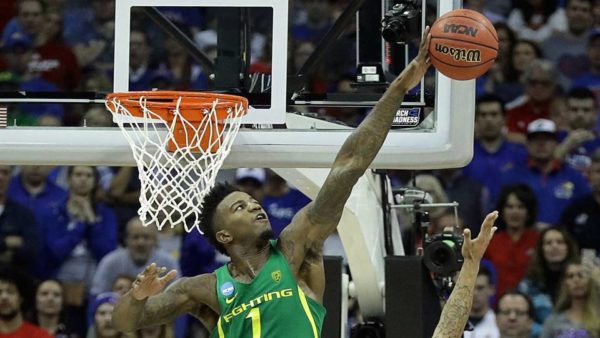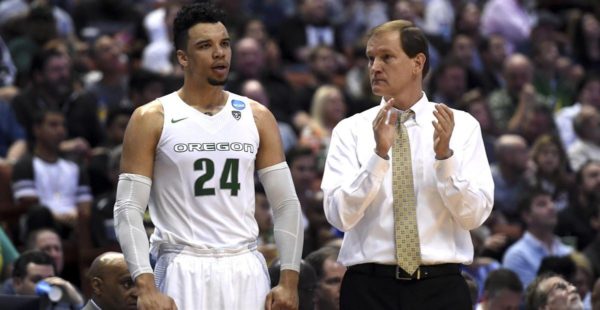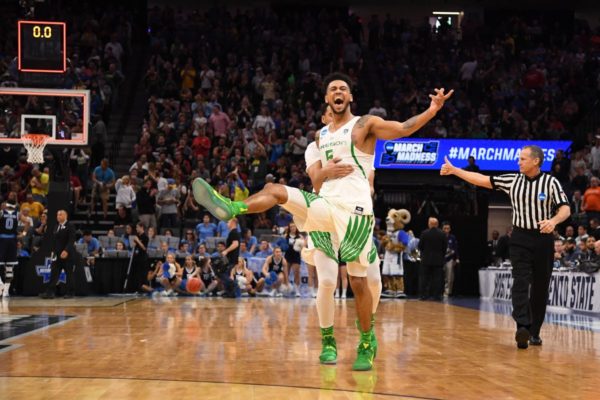Final Four Fact Sheet: Oregon Ducks
Posted by Tommy Lemoine on March 27th, 2017Now that we’re down to the Final Four, let’s take a deep dive into each of the four remaining teams. Today: Oregon.
How Oregon Got Here

Oregon hopes to continue riding high in Phoenix (Getty Images).
Midwest Region Champions. After receiving a lower-than-expected #3 seed on Selection Sunday, Oregon rolled past #13 Iona 83-67 in its NCAA Tournament opener. Two nights later, it required a pair of clutch Tyler Dorsey three-pointers for the Ducks to survive #11 Rhode Island, which led by as many as 10 points in the second half. Oregon’s late-game execution continued against #7 Michigan in the Sweet Sixteen, where it held the Wolverines scoreless over the game’s final two minutes en route to a 69-68 victory. Finally, despite facing #1 Kansas in Kansas City on Saturday—a road game by almost any standard—the Ducks drilled 11 three-pointers, held the Jayhawks to their worst offensive output of the season (0.94 points per possession), and advanced to their first Final Four since 1939.
The Coach
Dana Altman. The 58-year-old Nebraska native has quietly had one of the most successful careers among active Division I basketball coaches — a career now punctuated by his first Final Four appearance. Altman ranks 10th on the all-time wins list among working head men (597 wins), joining Jim Boeheim, Mike Krzyzewski, Roy Williams, Bill Self and Tom Izzo as the only active coaches with 20+ consecutive winning seasons. After spending 16 years at Creighton (and becoming the Bluejays’ all-time winningest coach in the process), Altman has turned an inconsistent Oregon program into a perennial threat to win the Pac-12. Prior to his arrival, the Ducks had reached the Sweet Sixteen three times in program history, and won 30+ games only once; since Altman took the job in 2011, Oregon has doubled that number of Sweet Sixteen appearances and won 30+ games twice. He may well be a future Hall of Famer.
Style
Offensively, Oregon doesn’t push the pace quite as much as it has in recent seasons, ranking just 122nd nationally in average possession length (16.9 seconds per possession), but just ninth overall in the Pac-12. One explanation for the Ducks’ slower pace may be that their half-court offense is so darn effective. With Dillon Brooks and Tyler Dorsey standing 6’7” and 6’4”, respectively (and no guards standing shorter than 6’2”) Oregon is very difficult to cover on the perimeter, capable of shooting over the top of smaller defenders seemingly at will. Altman’s club is shooting 43 percent from behind the arc during NCAA Tournament play, with Dorsey alone hitting 65 percent of his shots from distance (17-of-26 3FG). The Ducks are also very good at penetrating, especially with Brooks — a great ball-handler for his size — capable of muscling his way to the rim against smaller or slower defenders. On the other end of the court, Altman mixes defenses to great effect — match-up zone, zone press, man-to-man — helping Oregon slow down and confuse opposing offenses. The Ducks led the Pac-12 in defensive efficiency, block rate, and steal rate during the regular season. At 6’9”, Jordan Bell has been crucial to the team’s defensive success in March.
Strengths

Dana Altman has done a masterful job this March. (DuckTerritory – 247Sports)
- Perimeter Size. Even when the Ducks aren’t running set plays, it takes little more than a simple screen or a dribble hand-off for Brooks or Dorsey to find an open shot. At 6’7”, Brooks is incredibly difficult to stop off the dribble, able to use his size and physicality to create shots for himself or others around the rim. With Brooks, Dorsey, Dylan Ennis, Payton Pritchard, and Casey Benson all shooting better than 35 percent from three-point range, kicking back out to the perimeter is generally an effective option.
- Shooting ability. Oregon ranks 15th nationally in effective field goal percentage (55.8%), having shot a league-best 42.4 percent from three-point range in Pac-12 play and ranking among college basketball’s best from inside the arc (54.7% 2PT). With excellent perimeter size and a very good facilitator in freshman point guard Pritchard, the Ducks do a great job of locating open shooters (assisting on 56.6 percent of all made field goals) and capitalizing on those open looks. Of course, having a player like Dorsey helps — the dynamic sophomore is shooting an absurd 66 percent from the field in the NCAA Tournament.
- Defensive cohesion. Oregon put on a defensive showcase against Kansas on Saturday night, switching between zone and man-to-man throughout the game and virtually eliminating Josh Jackson’s impact (10 points on 3-of-8 FG; 0 points in the first half). Jordan Bell’s domineering presence underneath the basket prevented Jackson from scoring easy buckets at the rim or Frank Mason from finding easy pick-and-roll lobs to Landen Lucas, LaGerald Vick, and others. That rim protection (even without Boucher) combined with hard closeouts helped Oregon limit Kansas to a dismal 35 percent shooting from the field. The mixed defenses may’ve also gotten into the Jayhawks’ heads, as they hit only five of their 25 three-point attempts on the evening.
Weaknesses
- Interior depth. Boucher’s absence has forced Altman to essentially run a six-man rotation, with 6’11” Kavell Bigby-Williams seeing only slightly more minutes than he did before the injury. So while Bell has been sensational — committing a mere three fouls total in NCAA Tournament play — if he were to succumb to early foul trouble against North Carolina’s sizable frontcourt, Oregon would be in serious defensive trouble. No other player standing taller than 6’7” (Brooks) has played more than 15 minutes a game since February 1, and no player on the team possesses anywhere near Bell’s rim-protecting or offensive rebounding ability.
- Limiting three-point attempts. Kansas shot just 5-of-25 from behind the arc against the Ducks, without question a key reason why the Jayhawks lost. But what if five, even 10 more shots had gone in? It’s fairly well established at this point that defenses have little real impact on their opponents’ three-point percentage. And it’s also hard to deny that Oregon doesn’t do a great job of taking away the three-point line. In the NCAA Tournament alone, its opponents have averaged 26 three-point attempts per contest. If North Carolina (or Gonzaga or South Carolina) were to catch fire from behind the arc against the Ducks next weekend, Altman’s club could be in trouble. Then again, it does rank 18th nationally in three-point defense on the season (31.1% 3FG), so perhaps the Ducks are another statistical aberration.
- That missing piece. Boucher was more than just a shot-blocker (the country’s eighth-best, in fact) — he was a versatile forward capable of drawing defenders away from the basket with his three-point shooting capability (35% 3FG). Without him on the floor, the paint becomes more cluttered, limiting Brooks’ ability to find clear paths in the lane and inhibiting Oregon’s spacing. So far — thanks to Dorsey’s excellence from the perimeter and Bell’s dominance inside — the Ducks haven’t missed a beat. If Dorsey goes cold and Bell has an off night, though, Boucher’s absence will be felt.
Go-To Scorer

Reggie Miller called Tyler Dorsey ‘Mr. March’ on Saturday. At this point, it’s hard to argue. (Kyle Terada-USA TODAY Sports)
Tyler Dorsey (14.5 PPG). Brooks (16.3 PPG) is Oregon’s leading scorer and an undeniable key to its success, but it’s Dorsey — averaging 23.6 PPG since the Pac-12 Tournament began — who has led the Ducks offensively. Were it not for the sophomore’s 27-point, 9-of-10 FG performance against Rhode Island in the Round of 32, Oregon would no longer be playing. Likewise, his dagger three-pointer in the closing minutes against Kansas on Saturday helped squash any late momentum the Jayhawks were mustering. If the Ducks are going to beat North Carolina in Phoenix, the talented Los Angeles native must continue having a breakout March.
X-Factor
Jordan Bell (10.9 PPG, 8.6 RPG, 2.2 BPG). Bell, the Pac-12 Defensive Player of the Year, has been nothing short of dominant in the NCAA Tournament. After his 16-point, 13-rebound effort against Michigan in the Sweet Sixteen — included a game-winning offensive rebound — the junior became the first player since Hakeem Olajuwon in 1983 to record a double-double (11 points, 13 rebounds) with at least eight blocks. Considering his ability to protect the rim and secure offensive rebounds, Bell must remain on the floor against North Carolina, one of college basketball’s tallest teams.
Outlook
After Boucher’s injury, there was plenty of doubt surrounding Oregon’s chances in March — NCAA Selection Committee included. Clearly, those doubts were premature. Besides that 83-80 loss to Arizona in the Pac-12 title game, the Ducks have been mostly outstanding in March, saving perhaps their most complete performance of the season for Kansas on Saturday night. Assuming Bell stays out of foul trouble and Dorsey doesn’t go cold, there is no reason to think Altman’s resilient group can’t win a National Championship next week. North Carolina will be tough — Oregon is subpar on the defensive glass, while the Tar Heels rank first nationally in offensive rebounding percentage — but it’s hard to put anything past the Ducks at this point.









































